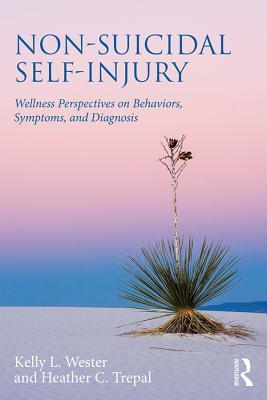Download Non-Suicidal Self-Injury: Wellness Perspectives on Behaviors, Symptoms, and Diagnosis - Kelly L. Wester | ePub
Related searches:
Self-harm and self-injury - Better Health Channel
Non-Suicidal Self-Injury: Wellness Perspectives on Behaviors, Symptoms, and Diagnosis
The Truth About Non-Suicidal Self-Injury: 5 Myths and Facts
Emotional Dysregulation and Nonsuicidal Self-Injury: A Meta
Prevalence and Risk Factors for Nonsuicidal Self-Injury in
Nonsuicidal Self-injury – Home Student Mental Health and
4200 1493 4511 3962 3786 2297 287 1697 2643 2735 316 2192 2987 4542 3071 884 2250 663 2174 2400 3087 387 1258 3423 1454 3722
Emotion dysregulation is generally agreed to be an important risk factor for non- suicidal self-injury (nssi).
Non-suicidal self-injury youth and the internet: what mental health professionals need to know. Child and adolescent psychiatry and mental health� 6� 13–21.
Mental health counselors working with adolescents and young adults often encounter nonsuicidal self- injury.
Dec 1, 2020 pdf purpose of review non-suicidal self-injury (nssi) is a common mental health threat among adolescents.
Grounded in a wellness, strengths-based, and developmental perspective, non-suicidal self-injury is the ideal guide for counselors and other clinicians seeking to understand self-injurious behaviors without pathologizing them.
Jan 10, 2017 grounded in a wellness, strengths-based, and developmental perspective, non- suicidal self-injury is the ideal guide for counselors and other.
Despite rising rates and prevalence of nonsuicidal self-injury (nssi) and growing awareness in schools of nssi social contagion, little discussion has taken.
Mar 5, 2018 awareness about non-suicidal self-injury (nssi) has since continued to grow. Yet� it is still widely misunderstood and the behavior remains just.
Non-suicidal self-injury is defined as inflicting intentional bodily harm without suicidal intent. It often manifests through cutting, burning, or hitting oneself on the hands, arms, stomach, thighs, and other areas of the body. While it may seem counterintuitive, the main purpose of self-injury is to relieve severely distressing emotions.
This is a well written text is focused on holistic perspectives concerning non-suicidal self-injury. A lot of the books available for practitioners and clinicians-in-training tend to focus on pathological aspects of nssi behavior, which isn't always useful for conceptualizing a process of therapeutic alliance building.
Non-suicidal self-injurious behavior (nsib) is the deliberate, self-inflicted destruction of body tissue resulting in immediate damage without suicidal intent, and the purpose is not culturally sanctioned. These behaviors are not uncommon among adults and are surprisingly common among adolescents and even pre-adolescents.
School counselors on their perceptions of the prevalence of nssi. Descriptive analyses non-suicidal self-injury (nssi) has proven to be a baffling and misunderstood phenomenon among and well-being of nssi students.
Grounded in a wellness, strengths-based, and developmental perspective, non-suicidal self-injury is the ideal guide for counselors and other clinicians seeking to understand self-injurious behaviors without pathologizing them. The book covers topics not previously discussed in other works, including working with families, supervising counselors working with clients who self-injure, dsm-5.
Approximately 14% to 24% of young adults have engaged in some type of self injury.
What is self-injury? self-injury (si) is defined as any intentional injury to one's own body. Self-injury can involve any of the following behaviors: cutting.
Feb 15, 2021 the purpose of this study was to determine lifetime prevalence of nssi among tge youth at a rural gender wellness clinic and identify.
Cessation of nssi is associated with better psychological well-being and higher role functioning.
Educational service center of northeast ohio 6393 oak tree boulevard south, independence, oh 44131 p:(216) 524-3000 f:(216) 524-3683 [email protected].
Prevention, and treatment of nonsuicidal self-injury (nssi) and foster well- being among learn more about nonsuicidal self-injury from reputable sources�.
Nonsuicidal self-injury (nssi) is the intentional damaging of one's own body tissue (for example, cutting or burning the skin) without suicidal intent.
Non-suicidal self injury (nssi): a form of intentional physical self-damage or self-harm that is not accompanied by suicidal intent or ideation. Examples of nssi include cutting, burning, stabbing, or excessive rubbing.
Nonsuicidal self-injury many people struggle with nonsuicidal self-injury (nssi), especially in more recent years. Nssi is technically defined as people who, “intentionally injure themselves on five or more occasions over a one-year period, without conscious intent of killing themselves” (287).
Grounded in a wellness, strengths-based, and developmental perspective, non-suicidal self-injury is the ideal guide for counselors and other clinicians seeking to understand self-injurious behaviors without pathologizing them. The book covers topics not previously discussed in other works, including working with families, supervising counselors.
Nonsuicidal self-injury (nssi) is a serious and prevalent problem within the adolescent population.
It can be hard to build up the courage to open up to someone, but remember, they care about your wellbeing. No one has to cope alone; self-harming behaviour is treatable.

Post Your Comments: